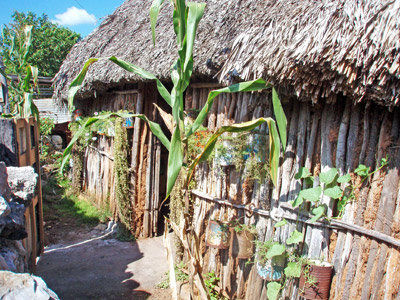
What would you plant if you lived in a flat area with very poor drainage? Where the landscape is shaped by limestone or dolomite bedrock, and the shallow soil is filled with carbonate rock? Where there is limited surface water and no above-ground rivers, and where lakes and swamps are present, but the water is marshy and not palatable for drinking? Where you have two seasons, six months of rain and six months dry, and — oh yeah — did I mention you get 100 inches of rain during the wet season?
Last week, I talked about the gardens and plantings I encountered while traveling in the mountainous areas of Chiapas in southern Mexico. I’m now in the heart of the Yucatan Peninsula in eastern Mexico, where extensive underground rivers collect in thousands of deep, cave pools called cenotes. More than 3,000 sinkholes of mineral-rich, clear, turquoise water dot the landscape. The Maya held the cenotes sacred, believing them to be entrances to the underworld.
Short and tall tropical jungles are the predominant natural vegetation, although the forests suffer from extensive deforestation. Orchards of papaya, maize, bananas, sweet and sour oranges, mandarins and limes are planted in cleared areas of the jungle. The soil is rocky and requires a lot of preparation before an orchard can be planted. It is interesting to note that oranges were originally introduced to the area from Spain in the 1700s.
More than half of Mexico’s resources are found in the Yucatan peninsula. Oil, plastics, bananas, mango and sisal are just a few of the exports of this area. In the 1600s, Captain Morgan repeatedly attacked ships off Campeche on the Gulf of Mexico. The ships, heading back to Spain, contained not Mexican gold and silver, but cocoa, corn, citrus and coconuts that were then unknown in Europe.
Perhaps the mild, tropical weather contributes to a lifestyle where people decorate the area around the house more than in the mountain regions. Bare dirt is swept clean of fallen leaves and debris. In the mountains, the residents planted more edible crops, rather than ornamental plants. Here in the Yucatan, flowers and container plants are common.
Many dwellings are made of gypsum plaster and stucco, as they have been since ancient times. Merida is called “the white city” due to the color of this common building material. In the villages, small branches are embedded in the plaster for strength, and thatched roofing is most often used, as it has been for centuries. This is an effective way to build weatherproof roofing with materials at hand. As experts in this type of roofing, they know the best reeds are harvested during the winter as standing dead material, ensuring that another reed plant will grow in its place the following year to maintain the roof.
Loquat trees and coconut palms shade houses from the sun, and spiky sisal agave plants are planted as effective barriers around the perimeter of the yard. Sugar cane and corn crops are typical. Front yards are small, but large backyards are filled with tables, chairs, hammocks and a clothesline.
Many small houses had rusted gallon cans planted with flowering vines and hung from the roof. I saw larger cans planted with ficus trees and bright, reddish-orange zinnias, a favorite nectar source for local butterflies. Fried pigskins are very popular, and some side yards were occupied by a 50-gallon drum of hot oil to produce this treat. I have to confess, I had to pass after seeing the product before the cooking process.
People of the Yucatan peninsula from Merida to Celestun on the Gulf of Mexico to the shores of the Caribbean enjoy their gardens, whether they live in small homes in rural areas or in more traditional residences in the city. My trip was amazing, and I’ll never forget the gardens of the Maya people.
Jan Nelson, a landscape designer and California certified nursery professional at Plant Works in Ben Lomond, will answer questions about gardening in the Santa Cruz Mountains. Contact her at ja******@*ol.com or JanNelsonLandscapeDesign.com.











